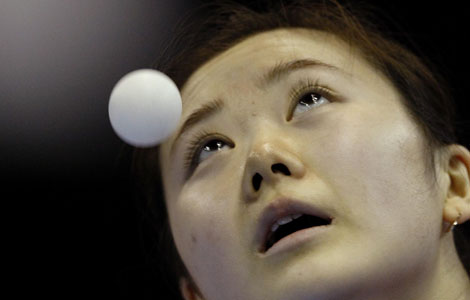Deal details begin to emerge as talks continue
Updated: 2011-11-28 16:31
(Agencies)
|
|||||||||
National Basketball Association (NBA) owners and players were busy putting the finishing touches to a new labor deal on Sunday as details of the tentative agreement began to emerge.
A day after a handshake deal was struck to end a five-month dispute and salvage the 2011-12 season, owners' representatives and players' union officials were hammering out the finer points of an agreement that still has to be ratified by both sides.
Before free-agent signings can begin and training camps open, 15-of-30 owners must approve the new collective bargaining agreement while the union needs a majority vote from its 430-plus members.
The players must also reform their union, which they dissolved on Nov 14, to pursue an anti-trust remedy to the labor dispute before putting the deal to a vote.
When the tentative agreement was announced on Saturday, details were vague beyond plans for a 66-game regular season that would open on Dec 25 with a triple-header featuring marquee teams like the Miami Heat, Los Angeles Lakers and champion Dallas Mavericks.
Selling the deal may prove difficult for both sides with some players saying they have made too many concessions while hard-line owners believe the opposite.
Saying they lost $300 million last season, owners entered negotiations demanding a hard salary cap system similar to the National Hockey League's, non-guaranteed contracts and a bigger cut of basketball-related income (BRI).
According to media reports, owners will get a bigger slice of the BRI pie with the 57 percent players received in the previous agreement trimmed to between 49 and 51 percent depending on various economic factors.
However, instead of an overhaul and a hard cap, owners settled for tweaks to the existing luxury tax cap system hoping they will be enough to bring parity to the league and keep big-spending, big-market teams from scooping up top players as Miami and New York have done.
While players took a cut in revenue, they gained major concession from the owners on complex "systems issues" allowing luxury tax-paying teams to keep some form of the mid-level exceptions and still able to participate in sign-and-trade deals - although both are believed to come with restrictions.
"I think (the deal) will largely prevent the high-spending teams from competing in the free agency market in a way that they have been able to in the past," NBA deputy commissioner Adam Silver told reporters.
"It is a compromise and it is not the system we sought out to get in terms of a harder cap but the luxury tax is harsher than it was in the past deal and we hope it's effective. This was not an easy agreement for anyone.
"Owners came in having suffered substantial losses and feeling the system wasn't working fairly across all teams and I certainly know the players had strong views about expectations in terms of what they should be getting from the system so it required a lot of compromise from both parties," said Silver.
While the owners and players have reached agreement in principle on major issues there are numerous other items in the reported 10-year deal that must be negotiated including drug-testing and the minimum age for league eligibility.










